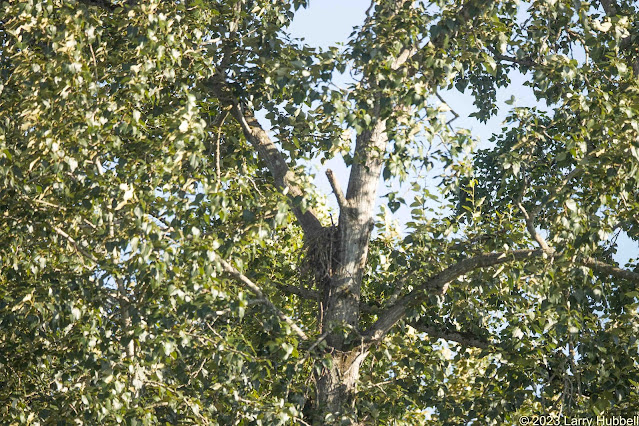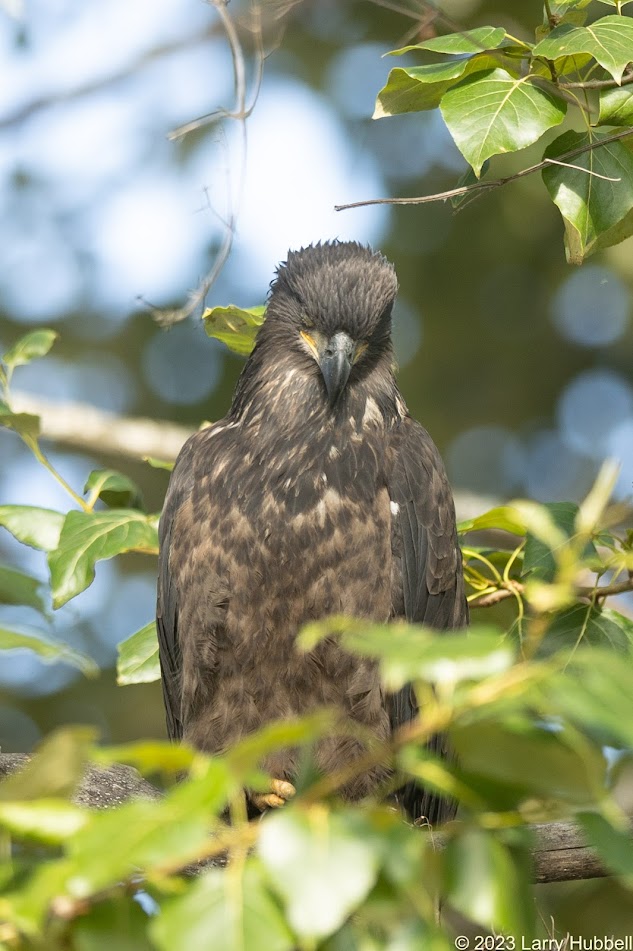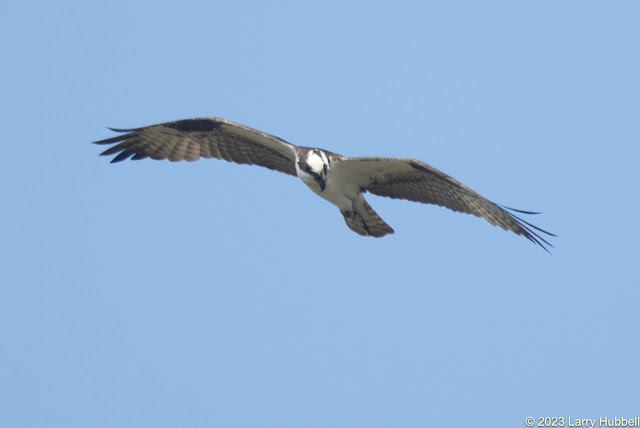On Wednesday morning, Monty and Marsha's young eaglet/fledgling was begging for food every forty-five seconds, on average. In my mind, the constant begging indicates the bird is hungry, However, it also implies that it has been eating and is healthy enough to have the strength to be constantly calling.
Last week, the eaglet did not leave the nest. The nest left it.
Unless you have a very clear memory, it can be hard to pick out the spot where something no longer exists. The following photo, from April, should help.
My most sincere thanks to all of you who let me know the nest was gone, especially since, I was out of town at the time. Thanks to Kris, Martin, Ronda, Marina, Susan, Sue, Anthony, and Jain! (If I have overlooked anyone else please forgive me.) It is wonderful to realize how much everyone cares about Monty and Marsha and how they, and their offspring, have become part of our community. A very special Thank You to Martin, Ronda, and Kris who have been very invested and have provided multiple updates and observations regarding the local Bald Eagles!
********
Breaking News - Nearby Eagles
Ronda would like everyone to know that Talia and Russ, the Bald Eagles that nest northeast of Yesler Swamp, have successful raised three fledglings this year. They are all, Victoria, Vivian and Vernon, on the wing and doing well! Thank you! Ronda.
********
This is virtually the identical perspective, as in the previous photo, but it was taken in the second week of April. The nest was impressive, especially when you think that Monty and Marsha selected and individually removed each cottonwood branch from nearby trees. One at a time, they flew them back to the nest. Essentially, the nest represents hundreds of flights and many, many hours of work.
By the way, in this photo, Monty is standing on Marsha's back. I suspect he was trying to persuade her that additional mating was needed to properly utilize the nest.
Moments later, Monty flew over and landed on the short, broken branch, that gave way when a previous version of the nest fell. This is the same broken branch that is nakedly apparent in the missing nest photo.
This fork in the tree has only two major branches. As a result, the nest looks like a saddle without a cinch (or without a third major support) to help hold it in place. Curiously, Monty and Marsha keep coming back to this tree and as close as possible to the same site. Sadly, their nests keep falling.
************
The posts below provide some history about Monty and Marsha, and their first fallen nest:
************
This nest location does have an excellent view of Union Bay and Montlake Cut but it sure seems like the larger cottonwood, immediately south of this one, might be structurally superior. We will just have to wait and watch to see when and where they build next year's nest.
My understanding is this nest fell a week ago Tuesday. The next day, the young one was seen sitting in the fork where the nest had been. By Thursday, he or she was no longer at the nest site (Thank you, Martin). Kris saw it on the ground on Thursday and then safely up in a tree on Friday. Early on Saturday morning, Marina saw it back on the ground. When I arrived I searched the cottonwood grove around the nest extensively but could not find it.
I did find the parents on top of an old world Cedar tree just southwest of the nest tree. I was just about to give up and head home when I happened to glance at a house across the street.
I was stunned to find the young one sitting on the chimney. I don't remember ever seeing Monty or Marsha, or one of their previous young, on a chimney or even a house. It reinforces the idea that as generations of birds live in the city they may become progressively more at ease with humans and the built environment.
The parents could easily see the young one from their perches in the Cedar tree. He or she was perfectly silent while I watched. I interpreted this as good news. I suspect, it had just been fed, which would explain its unusual silence with the parents nearby. Being perched high in the air reinforced the idea that the young bird could fly. Plus, it implied that its wings were functional and unharmed. Finally, the quiet presence of Monty and Marsha suggested that they fully accepted that this is their offspring, even though it was no longer in the nest, and that most likely they will continue executing their parental duties i.e. feeding and looking after it.
On Sunday, between Martin and I, we watched the young one all afternoon. Martin found it on the east side of the cottonwood grove and it stayed in basically the same small area the whole time.
Our best guess is the young one is just under three months old. At this point, it is or will most likely soon be larger than its parents. As this photo shows, it is fully equipped physically, with an adult-sized beak and talons. It has the tools, but has not yet developed the confidence and skill to secure its own food.
Notice the closed eyelid that is protecting the eye while the talons are nearby. I believe this is the nictitating membrane as opposed to the outer eyelid that matches its nearby feathers. The outer eyelid is partially visible in the last photo at the end of this post.
Often it would call for food.
Here is a quick example of the sound.
As I mentioned in the previous post about this young one. I suspect that its flight feathers may have grown nearly 1/2 inch per day during the last month or so.
Typically, when a young eagle fledges their flight feathers are the longest they will ever be. It will take two years for them to replace the feathers and the replacements will all be shorter. Apparently, a little extra lift when they are learning to fly helps them make the most dangerous transition of their lives. Essentially, nature gives them "training wheels".
In addition to begging for food, it would occasionally walk about among a limited set of branches, but it did not fly while I was there.
Once, it grabbed a twig on a branch.
I am uncertain whether this behavior displayed hunger, boredom, or just a youthful desire to explore everything. Although, I do remember another young eagle doing a somewhat similar exercise with a pine cone. You may read that story by Clicking Here.
Later in the afternoon, when I thought I heard one of the parents calling nearby. The young one became excited and moved in that direction.
However, it still stayed put. Its feathers seemed a bit askew. I think there are still more gaps between the feathers than what we see with adults. Perhaps, it still needs to do more preening, cleaning, and growing. I suspect the gaps make flight harder, but luckily, not impossible.
By staying in one general area for many hours I wondered if the young bird was essentially creating a virtual nest site.
Maybe the nest left the eaglet a little before it was truly ready to fledge.
Bald Eagle development is kind of similar to humans. They learn to fly before becoming independent, like a young person learning to drive before leaving home.
Surprisingly, Bald Eagle maturity is on a very different schedule. This young eagle will be independent, and hunting for all of its own food, by Winter. It will not be mature (with a white head and tail) for another four and a half to five years. It will not be ready to take a mate, declare a territory, build a nest, and raise young until after it matures.
In the meantime, if you visit the southeast corner of Montlake Cut and follow the sound of the begging calls you might get to see the parents returning with food for their "little" one.
On Sunday, many of the people who passed by asked what we were looking at. A common response, upon seeing a young fledgling eagle for the first time, is, "That's the Baby?"
In honor of the Coast Salish people, on whose land we live, it seems appropriate the call this young one, Bi?Bəda? Which I understand means Little Baby in Lushootseed.
It sounds like, "BeeBahDah", to me. You can hear it for yourself by Clicking Here.
Have a great day on Union Bay...where nature lives in the city and Black Birders are welcome!
Sincerely,
Larry
ps: If you have not yet responded to the Arboretum Foundation survey there is still time. Please Click Here and let us know what is important to you.
(I wish I had remembered to write about how important peace and quiet is in the Arboretum. Hearing the birds sing, the wind in the leaves, and the sound of flowing water is so much more soothing than the sounds of vehicular traffic. I wonder if Lake Washington Blvd could be closed on Sundays? or If we could add more speed bumps? Slower traffic makes much less noise and it is safer for all creatures - including humans!
Also important from nature's perspective, would be writing about the value of fish and access for them via Arboretum Creek, which needs to be removed from the pipe just upstream from the mouth of the creek.
Keystone plants are another great subject to help promote nature and birds. See more below.)
Each of us, who breathes the air, drinks water, and eats food should be helping to protect our environment. Local efforts are most effective and sustainable. Native plants and trees encourage the largest diversity of lifeforms because of their long intertwined history with our local environment and native creatures. Even the microbes in the soil are native to each local landscape.
I hope we can inspire ourselves, our neighbors, and local businesses to respect native flora and support native wildlife at every opportunity. I have learned that our most logical approach to native trees and plants (in order of priority) should be to:
1) Learn and leave established native flora undisturbed.
2) Remove invasive species and then wait to see if native plants begin to grow without assistance. (When native plants start on their own, then these plants or trees are likely the most appropriate flora for the habitat.)
3) Scatter seeds from nearby native plants in a similar habitat.
4) If you feel you must add a new plant then select a native plant while considering how the plant fits with the specific habitat and understanding the plant's logical place in the normal succession of native plants.
***************
Keystone native plants are an important new idea. Douglas Tallamy, in the book "Nature's Best Hope ", explains that caterpillars supply more energy to birds, particularly young birds in their nests, than any other plant eater. He also mentions that 14% of our native plants, i.e. Keystone Plants, provide food for 90% of our caterpillars. This unique subset of native plants and trees enables critical moths, butterflies, and caterpillars that in turn provide food for the great majority of birds, especially during the breeding season.
Note: Pollinators are also included as Keystone Plants.
This video explains the native keystone plants very nicely:
https://www.youtube.com/watch?v=O5cXccWx030
The Top Keystone Genera in our ecoregion i.e. Plants and trees you might want in your yard:
Click Here
Additional content available here:
https://wos.org/wos-wp/wp-content/uploads/2022/10/Native-Plant-Resources-10-7-22.pdf
***************
In the area below, I am displaying at least one photo each week to help challenge us to know the difference between native and non-native lifeforms.
A.
B.
C.
D.
Can you identify these four trees species that are members of the top ten Keystone tree genera in our ecoregion?
Scroll down for the answer.
******************
They are:
A = Vine Maple - Acer circinatum
B = Pacific Crabapple - Malus fascia
C = Oregon Oak - Quercus garrana
D = Bitter Cherry - Prunus emarginata
Here is their order, by genus, in terms of value to the greatest number of insect species and therefore birds"
Genus: Insect Species Count:
Quercus 436
Prunus 340
Acer 238
Malus 237
This information comes from the National Wildlife Federation. Click Here to see the supporting documentation.
Are partially eaten leaves good or bad for trees, butterflies, and birds?
Nature is complex. The more I learn the more my perspective changes. Previously, I thought of partially eaten leaf indicated an invasive insect was damaging a plant or tree. However, given the value of caterpillars to young birds, a few partially eaten leaves might really, be a sign of a functional ecosystem.
*****************
The Email Challenge:
Over the years, I have had many readers tell me that Google is no longer sending them email announcements. As of 2021, Google has discontinued the service.
In response, I have set up my own email list. With each post, I will manually send out an announcement. If you would like to be added to my personal email list please send me an email requesting to be added. Something like:
Larry, Please add me to your personal email list.
My email address is:
LDHubbell@comcast.net
Thank you!
*******************
The Comment Challenge:
Another common issue is losing your input while attempting to leave a comment on this blog. Often everything functions fine, however, sometimes people are unable to make it past the robot-detection challenge or maybe it is the lack of a Google account. I am uncertain about the precise issue. Sadly, a person can lose their comment with no recovery recourse.
Bottom Line: If you write a long comment, please, copy it before hitting enter. Then, if the comment function fails to record your information, you can send the comment directly to me using email.My email address is:
LDHubbell@comcast.net
Sincerely,Larry
A Parting Shot:




















































